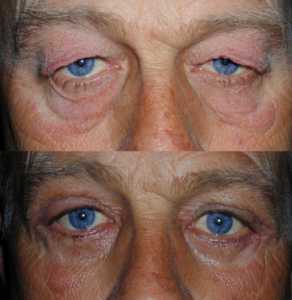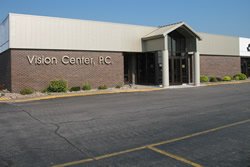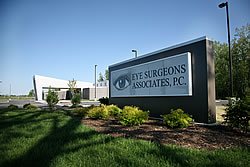 By Dr. Dan Repp ~
By Dr. Dan Repp ~
Drooping eyelids are the most common reason new patients visit an oculofacial specialist. Due to aging, drooping lids can also occur from pregnancy or result from repeated injury or trauma, frequent eyelid infections and swelling, excessive lid rubbing, eye surgery, and certain nerve disorders. The two most common types of drooping eyelids are ptosis (pronounced ‘toe-sis’) and dermatochalasis (pronounced “der-mato-ca-ley-sis”). Ptosis is a drooping of the eyelid itself, whereas dermatochalasis is excess eyelid skin cascading over the eyelashes.
I regularly use the analogy of a garage to explain the difference. In the garage analogy, the eyelid is the garage door and the excess eyelid skin, an awning blocking the door. A garage door hanging too low is like ptosis (a condition where the eyelid is too low). Dermatochalasis resembles an oversized, heavy awning blocking our view into the garage. With dermatochalasis, excess skin prevents us from seeing a patient’s whole eye.
In patients with excess eyelid skin (dermatochalasis), the eyelid is often in a good position behind the extra skin. But this isn’t always the case. Sometimes there is so much extra eyelid skin that the skin acts like a veil, hiding a drooping eyelid behind it. Put another way, some patients have both extra skin and a drooping eyelid, meaning they have both ptosis and dermatochalasis combined. In our analogy, this is the equivalent of having a large awning in front of a garage door that is too low. Knowing the difference between excess eyelid skin (dermatochalasis) and a low upper eyelid (ptosis) is essential because surgery to remove extra eyelid skin will not fix a drooping eyelid.
Surgery to fix excess eyelid skin is very different than raising a drooping upper eyelid. Fixing excess eyelid skin is the more straightforward of the two surgeries. Trimming back the excess skin in this surgery reveals a wider field of view. This surgery is called blepharoplasty, or commonly a “lid lift.”
Fixing a drooping eyelid (ptosis) is more complicated. Let’s carry our garage analogy a little further. A garage has a motor to lift the door and a chain connecting the motor to the door. The eyelid is similar, with a muscle that lifts the lid and a tendon-like structure connecting the muscle to the eyelid. If a garage door is too low, you could imagine removing chain links between the motor and the door to help raise the door. Surgery for drooping eyelids (ptosis surgery) is similar – tighten the connection between the eyelid and the lifting muscle to raise the eyelid/garage door. There are several ways to tighten the connection between the eyelid and the lifting muscle, but the underlying strategy is the same: tighten the connection and raise the eyelid.
Either procedure can be done for medical or aesthetic reasons, clearing central blurry vision, restoring normal peripheral vision and improving the cosmetic appearance of the eyelids. The methods typically are performed under local anesthesia on an outpatient basis. Vision is quite normal after surgery, enabling reading and other activities to be enjoyed during the recovery. There is swelling and bruising of the eyelid after surgery. Most of this is gone within five to seven days but can persist for up to 14 days in individuals who bruise easily.
Remember, comparing ptosis surgery to a “lid lift” is like comparing apples to oranges. The two surgeries are very different and have different risks and benefits. Your surgeon must match the eyelid surgery to your problem to accomplish the desired outcome.
BIO: Dr. Dan Repp completed a fellowship in ophthalmic plastic and reconstructive surgery and is certified by the American Board of Ophthalmology. He practices at Eye Surgeons Associates’ Bettendorf and Rock Island offices. For more information, please visit our Plastic and Reconstructive Surgery Services page.
The material contained in this article is for informational purposes only and is not intended to be a substitute for professional medical advice, diagnosis, or treatment. Always seek the advice of your physician or other qualified healthcare provider.




